Everybody deserves great pulled pork—even without a smoker. This is a true oven pulled pork recipe that uses a pork butt (also called a Boston butt), cooked low and slow at 250°F. The result? Juicy, tender shredded pork with a smoky bark that tastes like it came off the grill—with hardly any effort.
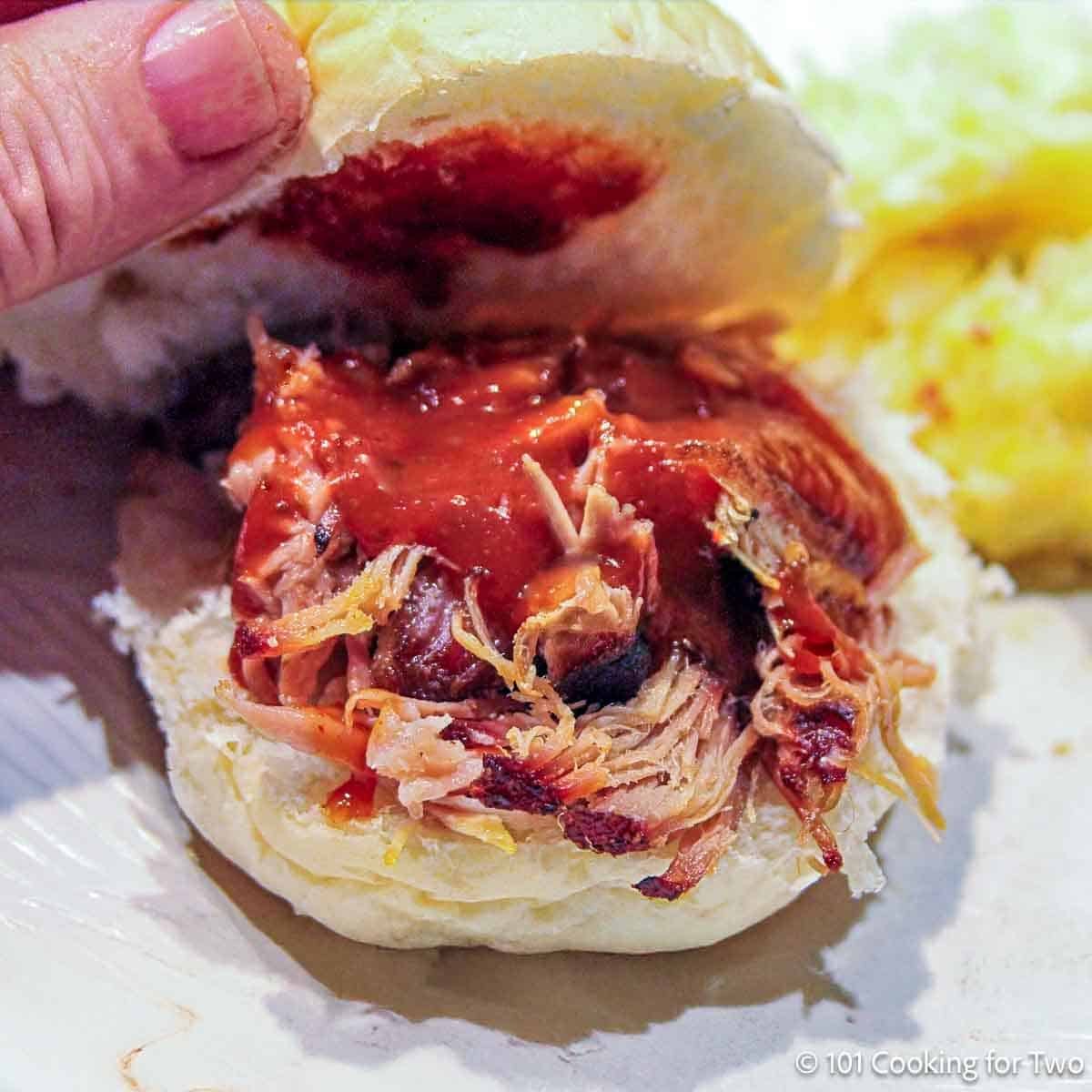
Jump To (scroll for more)
- ❤️ Why You’ll Love This Recipe
- 🐖Ingredients
- 👨🍳Quick Overview: How to Cook Pulled Pork in the Oven from Pork Butt
- ⏰ How Long to Cook Pork Butt in the Oven
- 🌡️ When is Pork Butt Done?
- 👨🍳Make It Right: Flavor Tips & Options
- 👍More Pulled Pork Recipes
- 🍽️Serving Pulled Pork
- 🧊 Storing Pulled Pork
- 🔥How to Reheat Pulled Pork
- ❓FAQs
- 📖The Recipe Card with Step-by-Step Instructions
Featured Comment by Lisa B :
⭐⭐⭐⭐⭐
"I was beyond amazed at the end product of this recipe. The cooking method is foolproof. People thought the pork was cooked on a smoker or grill. It was perfectly moist but with the crunchy texture of the bark mixed in. So easy! Outstanding results."
❤️ Why You’ll Love This Recipe
- No smoker? No problem: Get deep BBQ-style flavor with just your oven and a pork butt—no special equipment needed.
- Beginner-friendly and foolproof: Just rub, roast at 250°F, rest, and shred. No flipping, basting, or worrying about fire.
- Juicy pulled pork with real bark: Low and slow cooking melts fat and collagen while forming that irresistible crispy crust.
- Feeds a crowd or the freezer: Make a big batch once and enjoy easy meals for days—sandwiches, nachos, tacos, you name it.
DrDan says:
We make this oven pulled pork almost every month. With just 10 minutes of prep, you can simulate a smoker or grill right in your oven—just set it to 250°F, add a good dry rub, and use a little liquid smoke. The results? Tender, juicy pork with bark and flavor that says “BBQ,” not “shortcut.”
🐖Ingredients
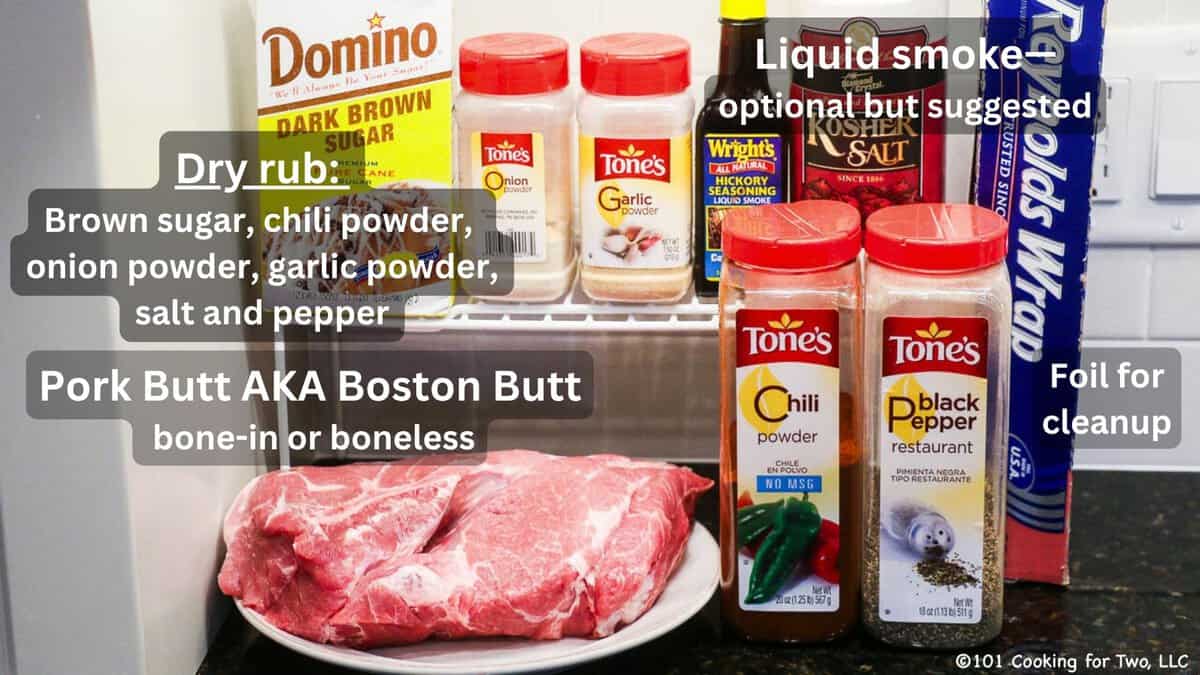
- Pork butt (aka Boston butt): Bone-in or boneless will work, but bone-in usually gives better bark and avoids netting issues.
✅Pro tip: Boneless roasts often come in netting, which can tear off the bark—remove it before cooking or go bone-in.
- Dry rub: Use your favorite pork rub or the simple homemade version in the recipe card. It's a mix of brown sugar, kosher salt, chili powder, garlic powder, onion powder, and black pepper.
Optional: Try my Memphis dry rub for a different flavor profile, or add a pinch of cayenne for heat.
- Liquid smoke (optional but recommended): Adds a smoky flavor and fills your kitchen with BBQ magic. Choose a high-quality brand like Wright’s with only “smoke” and “water” listed as ingredients.
👨🍳Quick Overview: How to Cook Pulled Pork in the Oven from Pork Butt
1. Preparing the pork butt:
Mix the dry rub. Pat dry the pork butt, coat with liquid smoke (optional), and apply the rub.
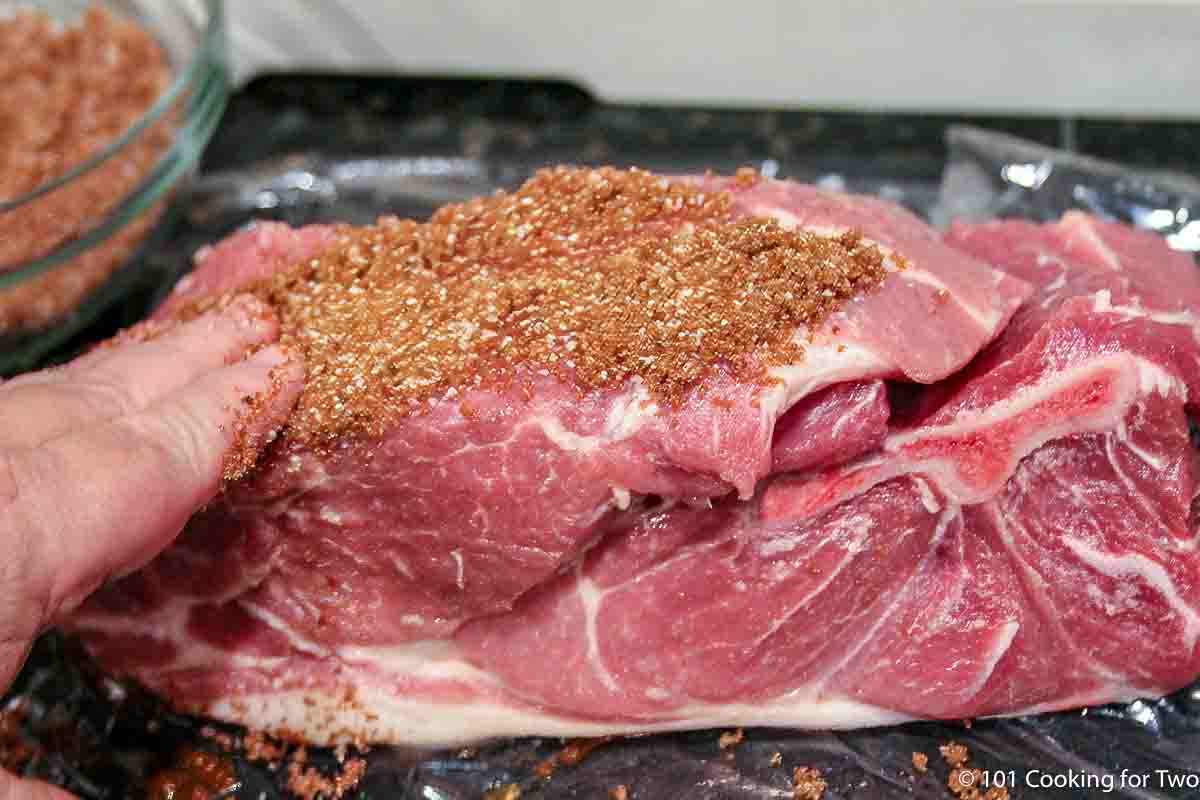
Place it on a foil-lined rimmed tray with a rack (recommended for better bark).
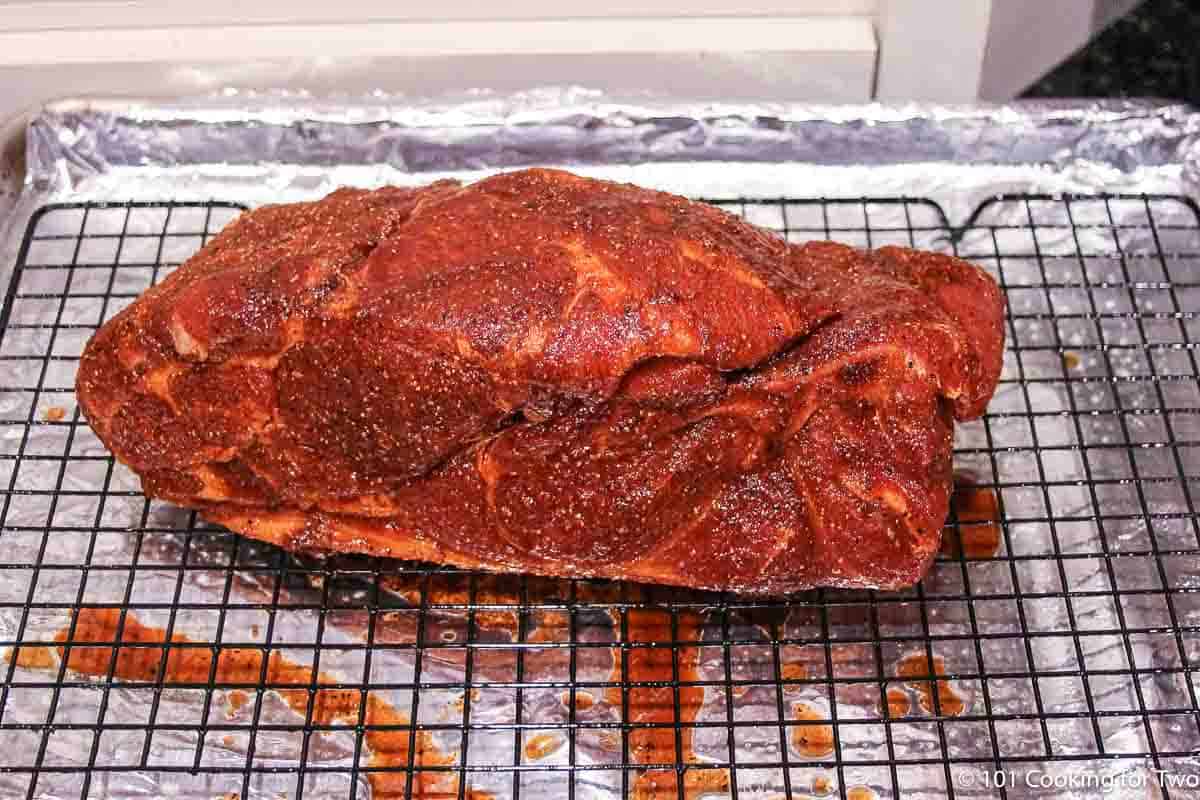
2. Roast low and slow:
Roast in a 250° oven until an internal temp of 200° to 205°—about 8-9 hours.

✅Pro Tip: No need to preheat or use convection. Just a center rack and steady heat.
3. Resting the meat:
Wrap tightly with foil, then several towels, and let rest in a small insulated cooler or on the counter for 1 to 2 hours.
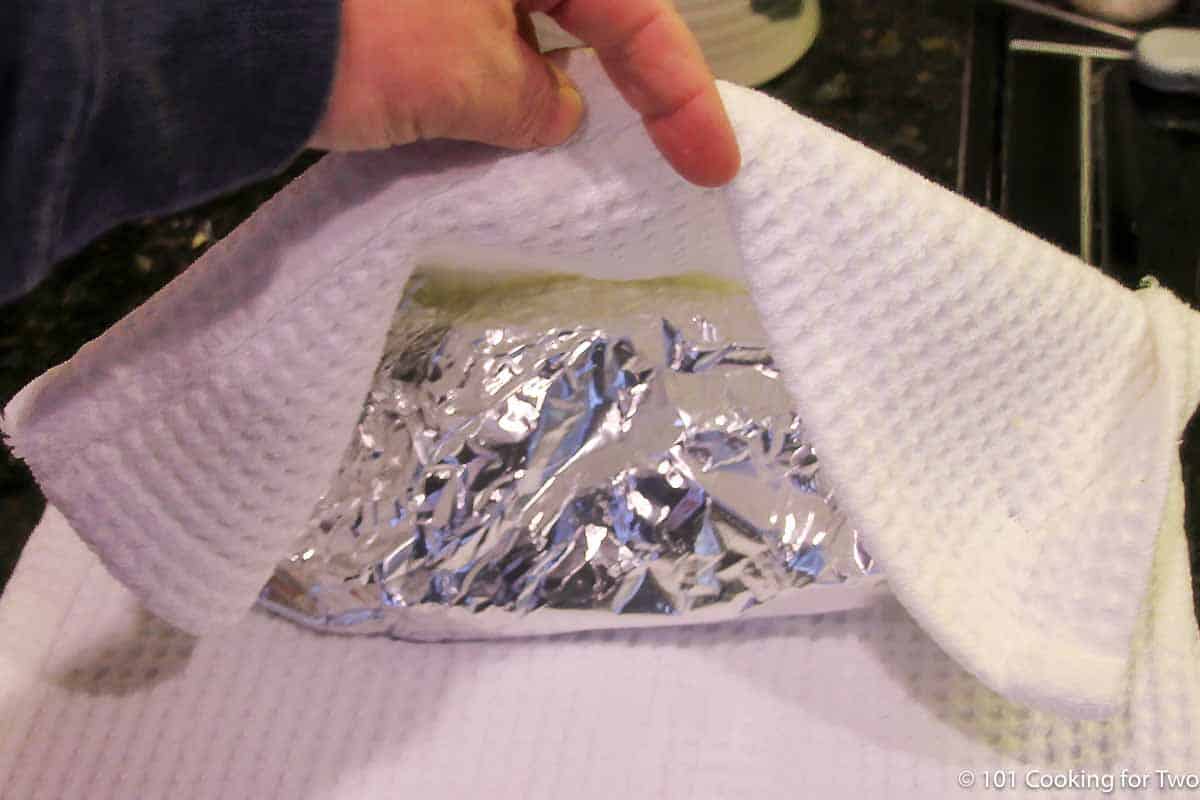
✅Pro Tip: Don’t skip the rest. It locks in moisture and makes shredding easier. Shred too soon, and the juices end up on your cutting board.
4. Shred and serve:
Shred with forks—it should fall apart easily and stay juicy, with crispy bark.
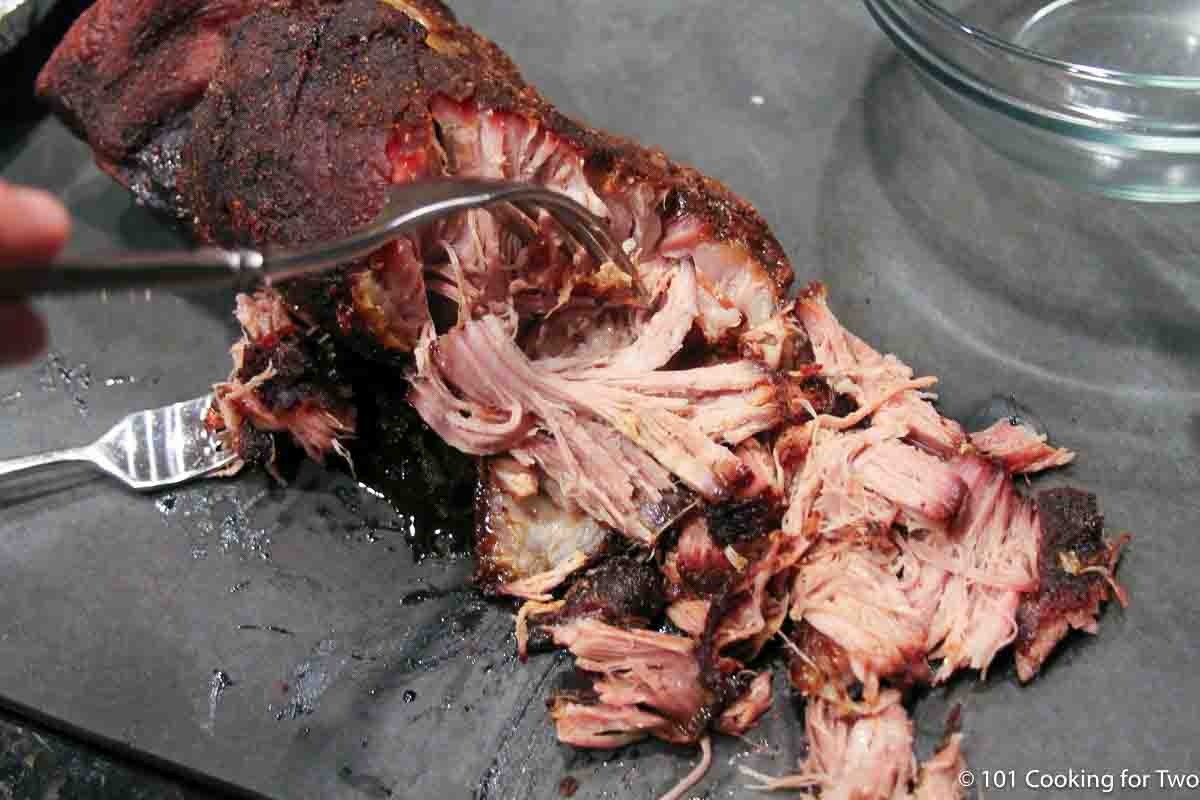
✅Pro tip: A well-wrapped pork butt can stay warm in a small insulated cooler for up to 4 hours before shredding. Never try to shred one that’s gone cold—it just won’t work.
For complete step-by-step instructions, scroll down to the printable recipe card or keep reading for tips, flavor options, and serving ideas.
⏰ How Long to Cook Pork Butt in the Oven
At 250°F, a 4-pound boneless pork butt will take about 8 to 9 hours in the oven. Bone-in cuts may take a little longer. A general guide is 2 hours per pound at 250°F—but actual time can vary between 1½ to 2½ hours per pound depending on the meat’s size and shape.
You can adjust the oven temperature slightly—225° to 275°F works—but avoid going higher. At 300°F or above, the outside may dry out before the collagen fully melts. Also, skip convection. It cooks unevenly and can dry the bark.
✅ Pro Tip: Some ovens will automatically shut off after 8 to 12 hours as a safety feature. Check your manual so you don’t wake up to a cold oven and half-cooked pork.
🌡️ When is Pork Butt Done?
Pork butt is done when it reaches an internal temperature of 200° to 205°F. That’s when the collagen fully breaks down and gives you that tender, juicy pulled pork texture.
The breakdown starts around 175°F, but don’t stop there—it’s not truly “pullable” until you hit 200° minimum.
You must use a meat thermometer and check the thickest part. Don’t rely on time, color, or guesswork—only the temperature tells the truth.
Save this recipe!
👨🍳Make It Right: Flavor Tips & Options
- Try a different rub: My Memphis dry rub brings a spicier, smokier finish. Or try my Chipotle Seasoning — it makes a bold dry rub when you add the optional brown sugar. Add cayenne for heat or smoked paprika for extra depth.
- Don’t want liquid smoke? Rub the pork with yellow mustard before the dry rub. It helps the bark form and adds a subtle tang.
- Split a big roast: If your pork butt is 6+ pounds, cut it in half to speed up cooking and create more surface area for bark. Space the pieces out on the rack. Cooking time will be closer to a 4–5 pounder.
👍More Pulled Pork Recipes
For more pulled pork recipes, try my Smoked Pork Butt on a Gas Grill or Crock Pot Pulled Pork. Craving carnitas? Check out Pork Carnitas in the Oven or Crock Pot Pork Carnitas—both made from pork butt and packed with flavor.
🍽️Serving Pulled Pork
We love pulled pork piled high on a toasted bun with Memphis BBQ Sauce. Add a scoop of coleslaw or your favorite condiments for a classic sandwich.
Not in a sandwich mood? Try it as a main dish with your favorite sides—or repurpose leftovers into nachos, tacos, or quesadillas.
🍴 Great Side Dishes
- Cold sides: Coleslaw, potato salad, Caprese Pasta Salad, or Macaroni Salad.
- Hot sides: Old fashioned cornbread, cheesy potato casserole, French Fries, or Mac and Cheese are also great sides.
🧊 Storing Pulled Pork
Store leftover pulled pork in an airtight container and refrigerate for up to 4 days—though I prefer using it within 2 days, since the texture tends to suffer.
For longer storage, pulled pork freezes well for 3 to 4 months. Many people portion it into reheatable freezer bags and reheat those bags directly in simmering water for a quick option.
🔥How to Reheat Pulled Pork
- Spread the pork out on a rimmed baking sheet.
- Sprinkle lightly with water or apple juice using your hand—just enough to moisten.
- Cover tightly with foil.
- Heat in a 250°–300°F oven until hot—usually 30 to 45 minutes, depending on the amount.
- Keep warm by lowering the oven temp or transferring to a crock pot on low or keep warm setting.
✅Pro Tip: Never reheat or store pulled pork with sauce already added. The acid breaks down the texture and turns it mushy.
❓FAQs
You don’t have to, but it helps. Elevating the pork on a rack (or crumpled foil) keeps it out of the fat drippings and helps the bark form more evenly. See Crock Pot Pulled Pork for an example of elevating with foil.
Nope. Leave it uncovered in the oven so the bark can develop properly. The pork stays moist from melted connective tissue, not steam.
You don’t need special tools. Use two forks to pull the meat apart. Any bone will slip out easily—just discard any tough bits or fat.
Yes—pork butt and Boston butt are the same cut. It comes from the upper shoulder of the pig, above the picnic shoulder. It’s full of connective tissue that melts during slow cooking, making it the best choice for juicy, tender pulled pork.
📖The Recipe Card with Step-by-Step Instructions
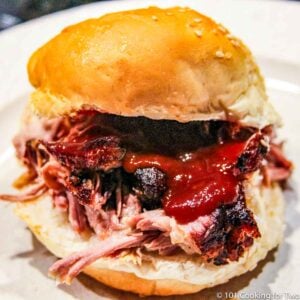
Oven Pulled Pork from Pork Butt (Low and Slow at 250°F)
Video Slideshow
Ingredients
- about 4 pounds Pork Butt - aka Boston Butt
- rub of your choice - good quality
- 2 tablespoons Wright's Liquid Smoke - optional but recommended
- ½ cup dark brown sugar
- 3 tablespoons Diamond Crystal kosher salt - 2 tablespoons if using Morton
- 1 tablespoon chili powder
- 1 teaspoon garlic powder
- 1 teaspoon onion powder
- 1 teaspoon black pepper
Step-by-Step Instructions
1. Preparing the pork butt:
- Use a rub of your choice. If using my rub, mix ½ cup dark brown sugar, 2 tablespoons kosher salt, 1 tablespoon chili powder, 1 teaspoon garlic powder, 1 teaspoon onion powder, and 1 teaspoon black pepper.
- Place a 4-pound (give or take a little) bone-in or boneless pork butt on a large piece of plastic wrap if prepping ahead. Rub with about 2 tablespoons of liquid smoke (optional).
- Use about 1 cup of rub and coat all sides of the pork butt generously. If you have time, wrap it in plastic wrap and refrigerate for a few hours or overnight. If not, go ahead and bake—it’ll still be great.
2. Roast low and slow:
- Prepare a large rimmed baking sheet lined with aluminum foil and a rack. Spray the rack heavily with PAM or oil.
- Place the pork butt on the rack and bake in a 250°F oven (no convection). No need to preheat. Fat cap up or down doesn’t matter. You can raise the temp to 275°F to shorten the cook time, but I recommend sticking with 250°F.
- Bake until the internal temperature reaches 200°–205°F—usually 8–9 hours. Time will vary based on size, bone-in vs. boneless, and oven behavior.
3. Resting the meat:
- Remove from the oven and place directly onto heavy-duty aluminum foil. Wrap tightly, then wrap in several towels. Let it rest for 1–2 hours. To extend the resting time and serve freshly pulled, place the wrapped pork in a small insulated cooler. It will stay warm for up to 4 hours if well-wrapped.
4. Shred and serve:
- Shred with forks. It should fall apart easily and stay juicy.
Recipe Notes
Pro Tips:
- Use the resting time to adjust serving time by a few hours if needed.
- If you don't have a rack, elevate the meat on rolled-up balls of foil—don’t let it sit in the fat.
- If using liquid smoke, I suggest sticking to Wright’s™. It should contain only “smoke” and “water.”
- My rub is provided for you, but use the rub of your choice.
- If you use my rub, the salt is calculated on Diamond Crystal Kosher salt. 1 teaspoon table salt = 1¼ teaspoon Morton kosher salt = 2 teaspoons Diamond Crystal kosher salt.
- The rub works well even if you cut the salt in half for a lower-sodium version.
- 195°F is the bare minimum temp, but 200°–205°F gives better results. and 210° is the max before things deteriorate.
- Store in the fridge for up to 4 days (I prefer 2 for best texture), or freeze for up to 4 months.
- Bone-in or boneless does not matter. But bone-in may take a bit longer.
- Fat pad up or down does not matter.
- I frequently just wet it with the liquid smoke, apply the rub, then directly into the oven. Without wrapping for a few hours.
- DO NOT cover the pork while baking. You want a dry oven to develop the bark.
- Nutrition info is approximate—fat drains off, bark holds seasoning, and every cut varies.
Your Own Private Notes
To adjust the recipe size:
You can adjust the number of servings above; however, only the amount in the ingredient list is adjusted, not the instructions.
Nutrition Estimate (may vary)
Editor's note: Originally Published November 2, 2013. Updated with expanded options, refreshed photos, and a table of contents to help navigation.



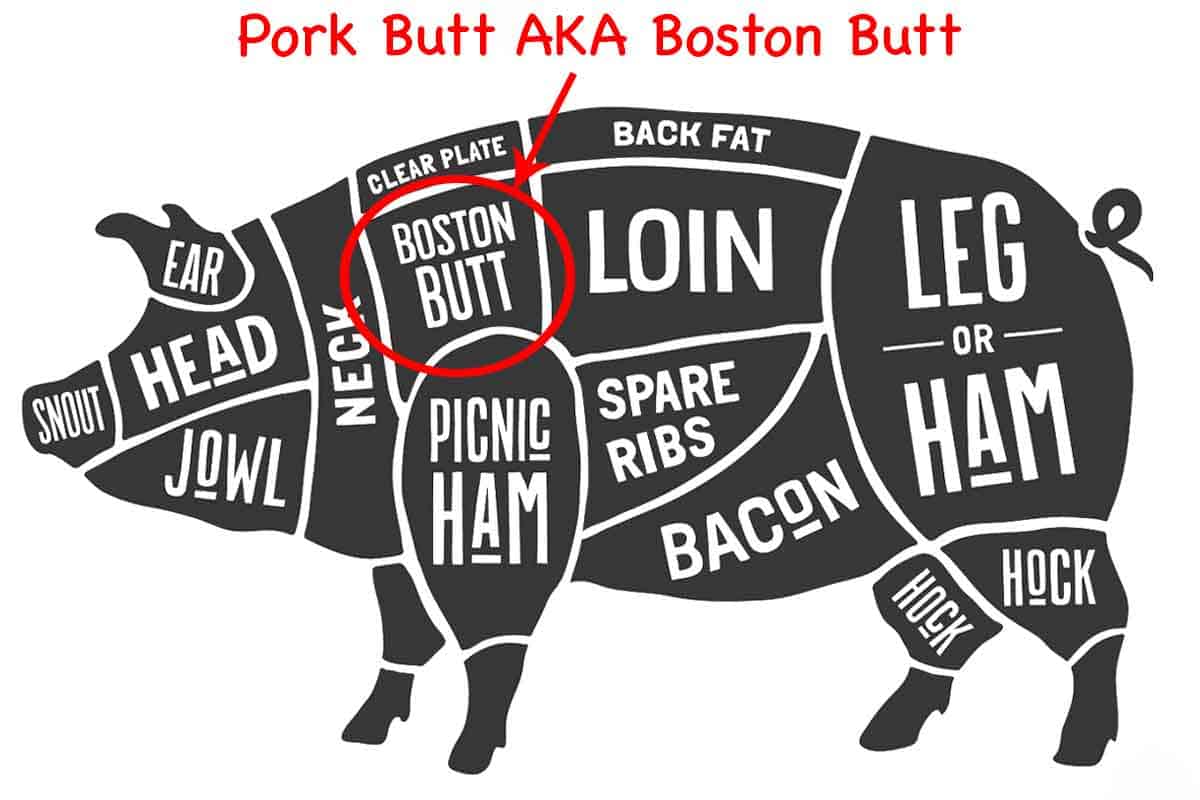
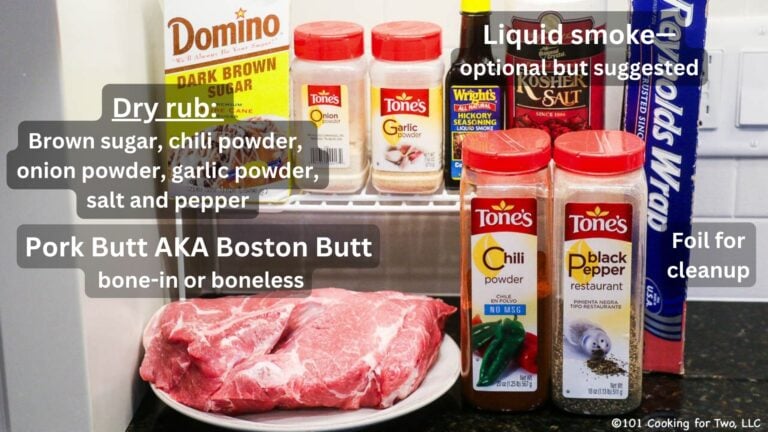
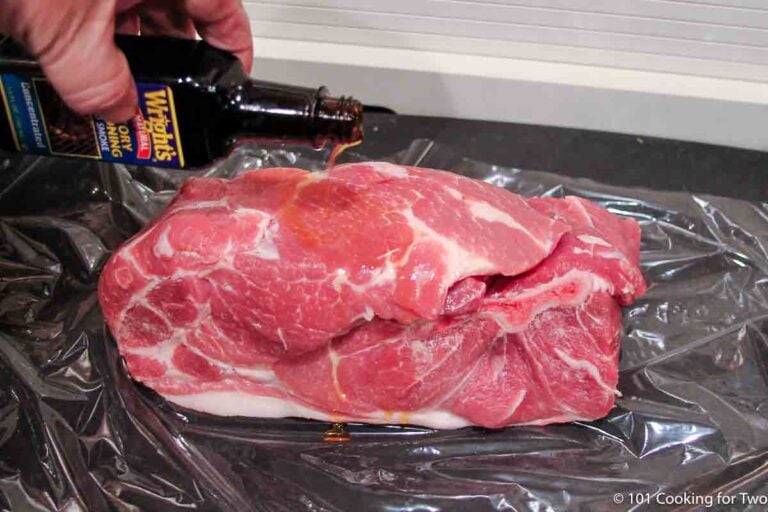
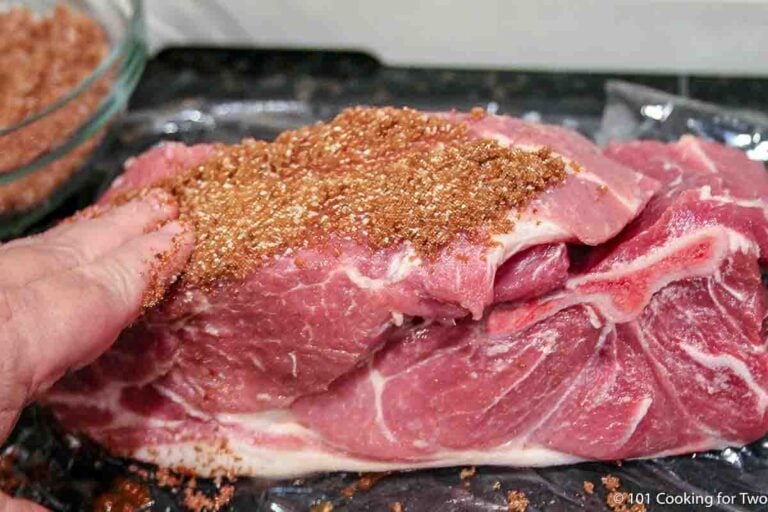

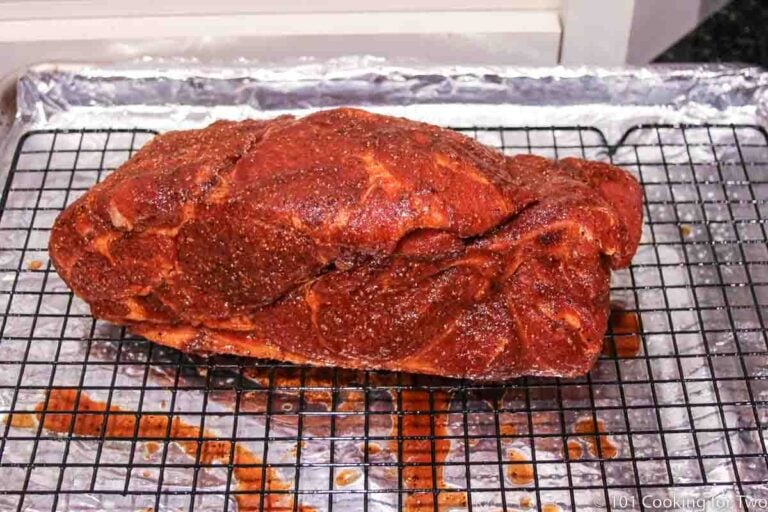
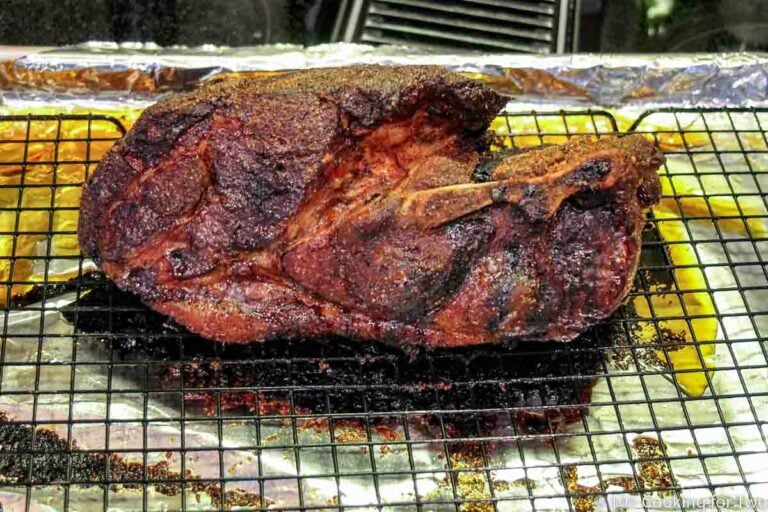

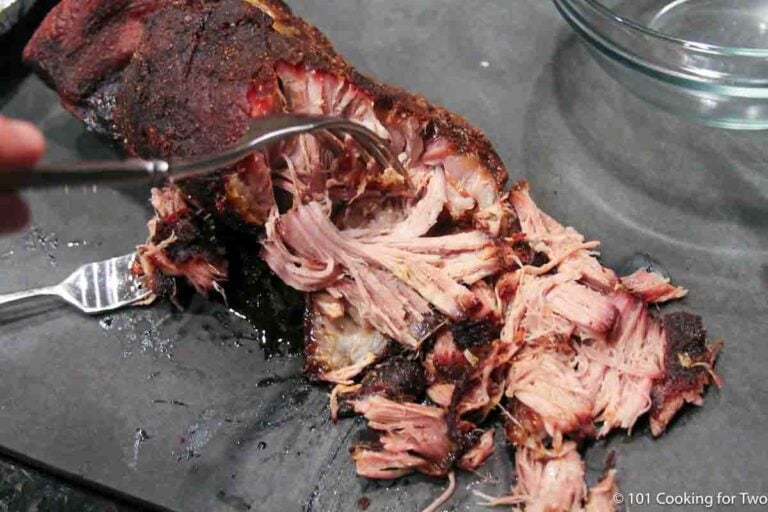
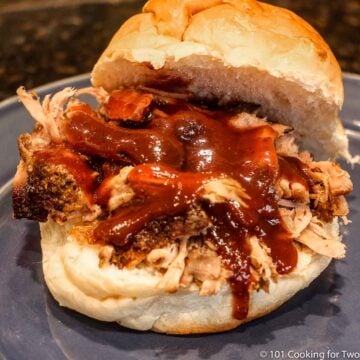
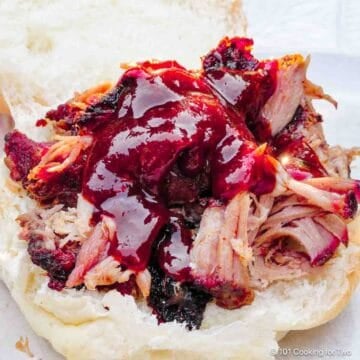
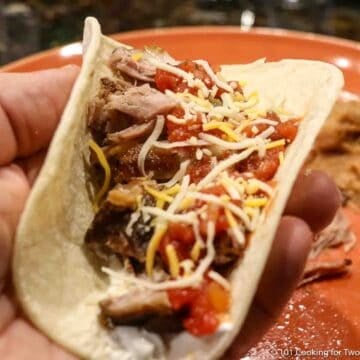
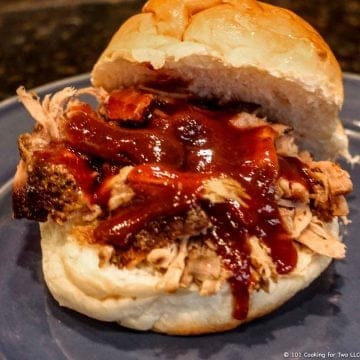
Tara L says
Hi Dr. Dan,
This is my all time favorite pulled pork recipe. I’ve been making it for years. I do have a question. I have always made this as written, however, this time I have a 2.5 pound boneless pork butt. What is your advice as far as time and temperature for such a small roast? Thank you!
Dan Mikesell AKA DrDan says
Hi Tara,
Welcome to commenting. The cooking time is more a function of the thickness than the weight. So, the shape matters. Flat and thin will be maybe 4-5 hours. While a thick brick like butt may take 6-7 hours. As always, cook to a final temperature.
Hope that helps
Dan